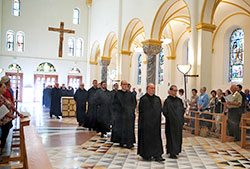Religious Vocations Supplement
Monastic life offers distinctive gifts to the Church and the world

With guests looking on, monks of Saint Meinrad Archabbey in St. Meinrad process into their Archabbey Church of Our Lady of Einsiedeln. For centuries, the monastic life has offered its own unique gifts to the service of the Church and the world. (Photo courtesy of Saint Meinrad Archabbey)
By Brother William Sprauer, O.S.B. (Special to The Criterion)
A charism is a spiritual gift given by God and, if properly recognized and cultivated, is shared for the benefit of others, giving life to the Church. The ancient tradition of monastic life, as one of many forms of consecrated life, offers the Church its own unique charism.
Distinctive vows
Religious orders follow Christ in a particular way by binding themselves to the three vows of poverty, chastity and obedience.
Monastic vows, while they indeed contain these three, are expressed in a slightly different manner. St. Benedict, directs new monks to “… come before the whole community in the oratory and promise stability, fidelity to the monastic life, and obedience.” We certainly share the vow of obedience, yet stability and fidelity are particular to the monastic life.
Stability of place calls the monk to stay in one place for life, the enclosure of the monastery, so that a stability of heart can take root in which the monk is able to seek Christ above all else. By committing oneself to a particular community, the monk allows that community to form him. Vowing stability, the monk does not to expect others to change, but allows others to change him to become more Christ-like.
Contained within the vow of fidelity to the monastic way of life are several other directives. Celibate chastity, poverty and conversatio (conversion) are all implicit in this vow of fidelity. The key word in the vow, interestingly enough, is not “fidelity,” but “monastic.” We bind ourselves to be faithful to this particular way of life, not any other way.
Monastic poverty takes the form of “holding all things in common.” While we are not expected to exhibit radical poverty, like that of St. Francis of Assisi, we are called to live a simple, unmaterialistic life, recognizing that ultimately we personally do not own anything.
Monks strive to live a life of continuing conversion, or conversatio morum (conversion of manners) as it is called in the Rule of St. Benedict. We strive each day, through prayer, work, community (and ultimately, self-discovery), to let go of those things that inhibit us from loving, from willing the good of another. The relentlessness of daily monastic life slowly wears on us, until our hard edges are smoothed and we more closely resemble Christ.
Distinctive place
Traditionally, monasteries are often found in a “deserted place,” away from the hustle and bustle of the city. Monks choose to leave “the world,” putting themselves on the fringe of society, while still connected to the Church at large, in order to seek Christ above all else.
This “flight” from the world is not because monks are running from something. Rather, they “step aside” to gain better perspective. Living apart in a cloister allows the monk to view the world from a distance, offering a fresh perspective while living a simple, quiet life of prayer and work within a close-knit community.
Distinctive prayer
Each monastery’s daily schedule brings the monks together several times a day to sing the praises of God through the Liturgy of the Hours, or “Work of God” as St. Benedict called it. Gregorian chant is the preferred monastic method of praying the psalms, and its use makes the liturgy reverent and dignified.
This constant returning to public prayer strengthens our relationship with Christ so that we become more attentive to his voice speaking to us in our daily lives.
Our private prayer comes in many different forms, be it lectio divina (contemplative praying of the Scriptures), the rosary, centering prayer or the Jesus Prayer. Although the form itself may differ, the goal is the same, to simply “rest in God.” Whatever devotion or prayer practice used to achieve this state of quiet contemplation is certainly up to the individual monk.
And so, our prayer does not cease, but follows us into our various tasks around the monastery. Our prayer bleeds into other areas of our lives, and begins to manifest itself in charitable works in the community and the Church at large.
While the Rule of St. Benedict doesn’t specify any particular type of work, monks tend to take on apostolates that allow for these regular intervals of liturgical and private prayer, so that prayer becomes the primary and persistent focus of a monk’s life.
Work is secondary to prayer, but is still a necessary part of the daily life of a monk. As St. Benedict says, “Idleness is the enemy of the soul.”
Monastic life offers a unique witness to the Church and to the world. Monks strive to cultivate Gospel values by living the Kingdom of Heaven this side of death, in a quiet and simple life. We believe that by living in continuing conversion through our contemplative prayer and work, we can change the world around us and make it a more loving place.
This is our charism. This is our received gift from God and, we in turn, continue to cultivate it, offering ourselves in prayer and witness for the Church and for the world, so that nothing will be preferred to the love of Christ.
(Benedictine Brother William Sprauer is a monk of Saint Meinrad Archabbey in St. Meinrad. For more information about Saint Meinrad Archabbey, log on to www.saintmeinrad.org.) †
